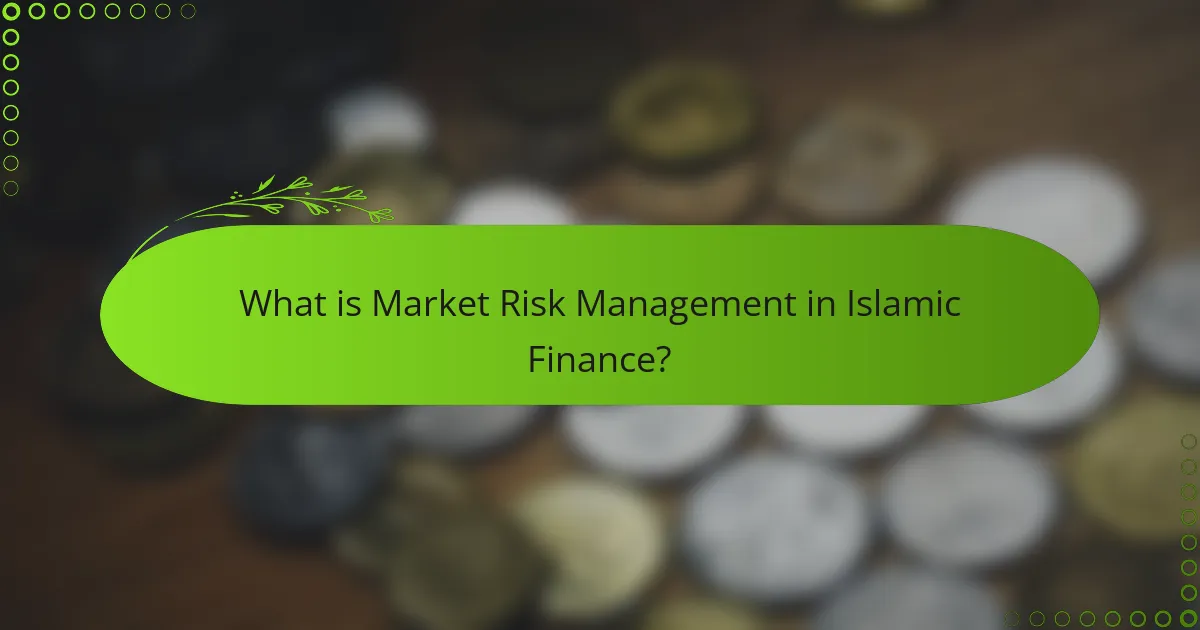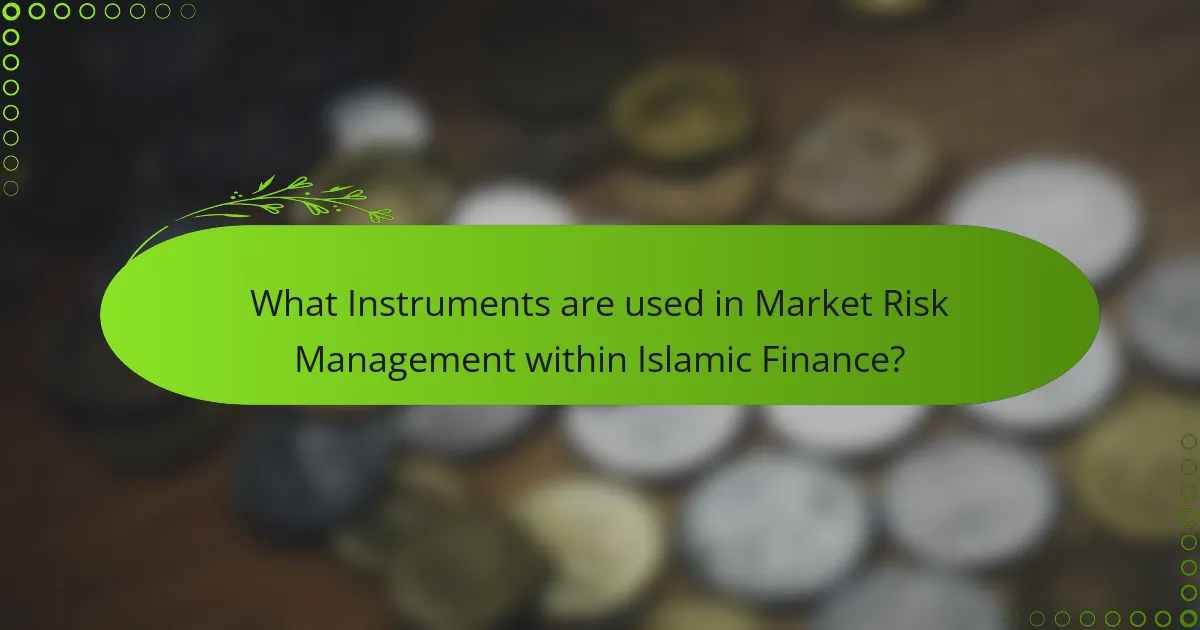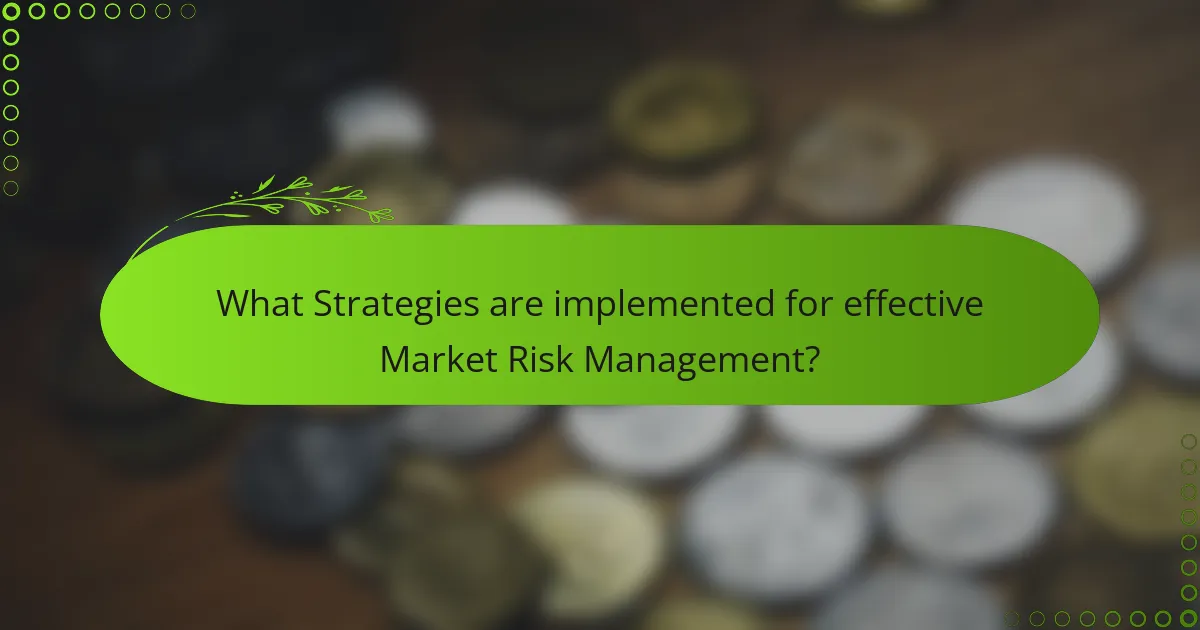
What is Market Risk Management in Islamic Finance?
Market Risk Management in Islamic Finance refers to the systematic approach to identifying, assessing, and mitigating risks associated with market fluctuations in accordance with Shariah principles. This includes managing risks related to changes in interest rates, foreign exchange rates, and commodity prices. Islamic finance prohibits excessive uncertainty (gharar) and interest (riba), which shapes its risk management strategies. Tools such as profit-sharing contracts (Mudarabah) and leasing agreements (Ijarah) are utilized to align risk and reward. Additionally, diversification and asset-backed financing are essential components of this management process. Effective market risk management in Islamic finance ensures compliance with ethical standards while protecting investors’ interests.
How does Market Risk Management differ from conventional finance?
Market Risk Management focuses on identifying, assessing, and mitigating risks associated with market fluctuations. Conventional finance primarily emphasizes maximizing returns and managing risks through diversification and financial instruments. In Market Risk Management, strategies are developed based on the volatility of assets and market conditions. This approach often incorporates quantitative models and stress testing to evaluate risk exposure. Conventional finance may rely more on historical performance and market trends without such rigorous assessments. Furthermore, Market Risk Management involves regulatory requirements specific to financial institutions. In contrast, conventional finance may not always prioritize compliance in the same manner. This distinction highlights the proactive nature of Market Risk Management compared to the more reactive strategies often seen in conventional finance.
What are the key principles of Islamic finance that influence market risk management?
The key principles of Islamic finance that influence market risk management include the prohibition of riba (interest), gharar (excessive uncertainty), and the requirement of ethical investments. Riba prohibits earning interest on loans, which affects how financial instruments are structured. Gharar restricts transactions with excessive uncertainty, guiding the creation of transparent contracts. Ethical investments ensure that funds are not allocated to haram (forbidden) activities, promoting socially responsible practices. These principles promote stability and reduce risk exposure in financial transactions, aligning with Shariah law. They also encourage risk-sharing mechanisms, such as profit and loss sharing, which distribute risk among parties involved. This framework leads to a more sustainable and equitable financial environment.
How do Shariah-compliant instruments mitigate market risk?
Shariah-compliant instruments mitigate market risk by adhering to Islamic finance principles that promote ethical investment. These instruments avoid speculation and excessive uncertainty, which can lead to market volatility. By investing in tangible assets, Shariah-compliant instruments create inherent value, reducing exposure to market fluctuations. For instance, Sukuk, or Islamic bonds, are backed by physical assets, providing stability. Additionally, profit-sharing contracts like Mudarabah align the interests of investors and entrepreneurs, fostering a balanced risk-sharing environment. This structure enhances resilience against market downturns, as risks are distributed rather than concentrated. Overall, Shariah-compliant instruments offer a framework that inherently minimizes market risk through ethical and tangible investment practices.
Why is Market Risk Management important in Islamic finance?
Market risk management is crucial in Islamic finance to ensure compliance with Shariah principles. Islamic finance prohibits excessive uncertainty and speculation, which are common in traditional financial markets. Effective market risk management helps identify, assess, and mitigate risks associated with market fluctuations. This is essential for maintaining the stability and integrity of financial institutions. Furthermore, it protects the interests of investors and promotes trust in Islamic financial products. According to a study by the Islamic Financial Services Board, effective risk management frameworks enhance the resilience of Islamic financial institutions during market volatility. Thus, market risk management is vital for the sustainable growth of the Islamic finance sector.
What are the potential impacts of market risk on Islamic financial institutions?
Market risk can significantly affect Islamic financial institutions. It may lead to fluctuations in asset values, impacting profitability. Changes in interest rates can create challenges, as Islamic finance prohibits interest-based transactions. Currency risk can also arise, affecting international investments and trade. Additionally, market volatility can increase liquidity risk, making it harder for institutions to meet obligations. These factors can ultimately threaten the financial stability and operational effectiveness of Islamic financial institutions.
How does effective market risk management enhance financial stability?
Effective market risk management enhances financial stability by identifying and mitigating potential financial losses. It helps institutions understand their exposure to market fluctuations. By implementing robust risk assessment frameworks, organizations can make informed decisions. This proactive approach reduces the likelihood of financial crises. Historical data shows that banks with strong risk management practices experience fewer defaults. For instance, during the 2008 financial crisis, institutions with effective risk controls fared better. Regulatory bodies emphasize the importance of risk management to safeguard the financial system. Thus, effective market risk management is crucial for maintaining overall economic health.

What Instruments are used in Market Risk Management within Islamic Finance?
Islamic finance employs various instruments for market risk management. These instruments include Sukuk, which are Islamic bonds that comply with Sharia law. They provide a fixed income stream while avoiding interest, which is prohibited in [censured]. Another instrument is Murabaha, a cost-plus financing structure that mitigates risk through transparency in pricing. Additionally, Islamic financial institutions use options and forwards that are structured to comply with Sharia principles.
Hedging strategies in Islamic finance often utilize Takaful, a cooperative insurance model, to manage risks. The use of these instruments is supported by regulatory frameworks in various Islamic finance jurisdictions. For instance, the Accounting and Auditing Organization for Islamic Financial Institutions (AAOIFI) sets standards that guide the use of these instruments. These instruments collectively help in managing exposure to market fluctuations while adhering to Islamic ethical standards.
What are the primary financial instruments utilized?
The primary financial instruments utilized in market risk management in Islamic finance include Sukuk, Murabaha, Ijara, and Mudarabah. Sukuk are Islamic bonds that represent ownership in an asset. They provide returns based on the performance of the underlying asset. Murabaha is a cost-plus financing structure where the seller discloses the cost and profit margin to the buyer. Ijara is a leasing agreement that allows the use of an asset while ownership remains with the lessor. Mudarabah is a profit-sharing contract where one party provides capital and the other provides expertise. These instruments comply with Sharia law and help mitigate risks while promoting ethical financial practices.
How do Sukuk function as a risk management tool?
Sukuk function as a risk management tool by providing a Sharia-compliant investment structure that mitigates financial risks. They are asset-backed securities that allow investors to participate in the ownership of tangible assets. This structure reduces risks associated with conventional debt instruments. Sukuk holders receive returns linked to the performance of the underlying assets. This linkage aligns investor interests with asset performance, minimizing credit risk. Additionally, Sukuk diversify funding sources, reducing reliance on traditional financing. They also enhance liquidity in the market by offering tradable instruments. According to a report by the Islamic Financial Services Board, Sukuk issuance reached $140 billion in 2020, indicating their growing importance in risk management.
What role do Islamic derivatives play in managing market risk?
Islamic derivatives play a crucial role in managing market risk by providing risk mitigation tools compliant with Sharia law. These instruments, such as swaps and options, allow for the transfer and management of financial risks without engaging in prohibited activities like speculation or interest. They enable Islamic financial institutions to hedge against fluctuations in asset prices, currency rates, and commodity prices. For instance, profit-sharing contracts and forward sales can stabilize cash flows and reduce exposure to market volatility. Additionally, Islamic derivatives enhance liquidity in the market, facilitating better risk management strategies. Their design aligns with ethical investment principles, ensuring that risk management adheres to Islamic finance tenets.
How are these instruments structured to comply with Shariah law?
Islamic financial instruments are structured to comply with Shariah law by avoiding interest (riba) and promoting risk-sharing. They incorporate profit-and-loss sharing models, such as Mudarabah and Musharakah. Mudarabah involves a partnership where one party provides capital while the other manages the investment. Musharakah is a joint enterprise where all partners contribute capital and share profits and losses.
Additionally, these instruments must not involve prohibited activities (haram), such as gambling or alcohol. They are often backed by tangible assets to ensure they have intrinsic value. Contracts are designed to be transparent, with clear terms regarding profit distribution and risk allocation.
Shariah boards review and approve these structures to ensure compliance with Islamic principles. This oversight includes verifying that the investment activities align with ethical guidelines.
What are the key features of Shariah-compliant financial contracts?
Shariah-compliant financial contracts have several key features. They must adhere to Islamic law, which prohibits interest (Riba). Contracts must involve tangible assets or services. They emphasize risk-sharing between parties rather than risk transfer. Transactions should be free from excessive uncertainty (Gharar). Ethical investments are a requirement, avoiding businesses related to alcohol, gambling, and other prohibited activities. Profit and loss sharing mechanisms are often employed, such as Mudarabah and Musharakah. These features ensure that Shariah-compliant contracts promote fairness and justice in financial dealings.
How do scholars ensure compliance in market risk management instruments?
Scholars ensure compliance in market risk management instruments by establishing frameworks that align with regulatory standards. They analyze existing regulations to identify key compliance requirements. This analysis includes reviewing guidelines set by financial authorities. Scholars also develop risk assessment models to quantify potential market risks. These models help in ensuring adherence to risk limits and thresholds. Additionally, they promote the integration of ethical standards in financial practices. Empirical studies validate the effectiveness of these compliance frameworks. Research shows that adherence to these frameworks enhances overall market stability.

What Strategies are implemented for effective Market Risk Management?
Effective market risk management strategies include diversification, hedging, and the use of risk assessment tools. Diversification involves spreading investments across various assets to reduce exposure to any single asset’s risk. Hedging strategies, such as options and futures, can protect against adverse price movements. Risk assessment tools, like Value at Risk (VaR) and stress testing, help quantify potential losses. Additionally, regular monitoring of market conditions and adjusting strategies accordingly is crucial. Historical data supports these strategies, demonstrating their effectiveness in mitigating risks.
What risk assessment techniques are commonly used?
Commonly used risk assessment techniques include qualitative and quantitative methods. Qualitative techniques involve expert judgment and scenario analysis. They focus on identifying potential risks and their impacts without numerical data. Quantitative techniques utilize statistical models and historical data. These methods calculate risk probabilities and potential losses. Common quantitative tools include Value at Risk (VaR) and stress testing. VaR estimates the maximum potential loss over a specified period. Stress testing evaluates performance under extreme market conditions. Both techniques are essential in market risk management, particularly in Islamic finance, to ensure compliance and stability.
How do scenario analysis and stress testing apply in Islamic finance?
Scenario analysis and stress testing are essential tools in Islamic finance for assessing market risks. They help financial institutions evaluate the impact of adverse market conditions on their portfolios. Scenario analysis involves creating hypothetical situations to forecast potential financial outcomes. Stress testing examines the effects of extreme but plausible adverse scenarios.
In Islamic finance, these methods must comply with Shariah principles. This means ensuring that the scenarios do not involve prohibited activities, such as excessive uncertainty (gharar) or interest (riba). Financial institutions apply these analyses to ensure their risk management strategies align with Islamic law.
For instance, a bank may simulate a scenario where commodity prices drop significantly. This helps in understanding how such a decline would affect profit-sharing investments. Stress testing could involve assessing the impact of a sudden economic downturn on liquidity.
These practices enhance the resilience of Islamic financial institutions. They ensure that these entities remain stable during financial shocks, maintaining compliance with ethical guidelines.
What methodologies enhance risk measurement in Islamic financial products?
Quantitative methodologies enhance risk measurement in Islamic financial products. These methodologies include Value at Risk (VaR) and stress testing. VaR quantifies potential losses in a portfolio under normal market conditions. Stress testing evaluates the impact of extreme market events on financial products.
Additionally, scenario analysis assesses how different economic conditions affect product performance. The use of Islamic finance-specific models, such as the Shariah-compliance risk assessment framework, is crucial. These models address unique risks associated with Islamic financial principles.
Empirical studies indicate that integrating these methodologies improves risk assessment accuracy. For instance, a study by Ariff and Can (2019) highlights the effectiveness of VaR in Islamic banking. This demonstrates the importance of tailored methodologies in enhancing risk measurement.
What are best practices for managing market risk in Islamic finance?
Best practices for managing market risk in Islamic finance include diversification of investment portfolios. This strategy reduces exposure to any single asset’s volatility. Implementing Sharia-compliant hedging techniques is also essential. These techniques may include using options and swaps that comply with Islamic law. Regular monitoring of market conditions and financial instruments is crucial. It allows for timely adjustments to strategies as needed. Engaging in rigorous risk assessment frameworks enhances decision-making processes. Furthermore, maintaining transparency and ethical standards builds trust with stakeholders. These practices collectively contribute to effective market risk management in Islamic finance.
How can institutions develop a robust risk management framework?
Institutions can develop a robust risk management framework by implementing a structured process. This process involves identifying, assessing, and prioritizing risks. Institutions should establish clear risk governance structures. These structures define roles and responsibilities for risk management. Regular risk assessments help in understanding the risk landscape. Institutions need to employ quantitative and qualitative methods for risk evaluation. They should also integrate risk management into strategic planning. Continuous monitoring of risk exposure is essential. Finally, institutions must ensure compliance with regulatory requirements related to risk management.
What role does continuous monitoring play in risk management strategies?
Continuous monitoring is essential in risk management strategies as it enables timely identification of potential risks. This proactive approach helps organizations to mitigate threats before they escalate. Continuous monitoring involves regularly assessing risk factors and the effectiveness of risk controls. It ensures that changes in the market environment are promptly addressed. For instance, financial institutions often utilize real-time data analysis to adjust their risk profiles. According to the Basel Committee on Banking Supervision, effective monitoring can enhance decision-making processes and improve overall risk management. This practice is crucial in the dynamic landscape of Islamic finance, where compliance with Sharia principles must be consistently verified.
What are some successful case studies in Islamic finance market risk management?
Some successful case studies in Islamic finance market risk management include the implementation of Sharia-compliant hedging instruments. One notable example is the use of Islamic swaps by Bank Negara Malaysia. This approach mitigated interest rate risk while adhering to Sharia principles. Another case is the Dubai Islamic Bank’s adoption of a risk management framework that incorporates stress testing and scenario analysis. This framework effectively manages market volatility and currency risk. Additionally, Qatar Islamic Bank successfully utilized commodity murabaha contracts to hedge against price fluctuations in the oil market. These case studies demonstrate effective strategies in aligning risk management with Islamic finance principles.
What lessons can be learned from notable Islamic financial institutions?
Notable Islamic financial institutions teach several key lessons in market risk management. They emphasize the importance of Sharia compliance in financial products. This ensures ethical investment and risk-sharing principles. Diversification is crucial to mitigate risks effectively. Institutions often employ profit-loss sharing models, aligning interests of stakeholders. Transparency in transactions builds trust among clients and investors. They also demonstrate the significance of robust governance frameworks to manage risks. Lastly, their focus on social responsibility can enhance brand loyalty and customer retention. These practices contribute to resilience in volatile markets.
How have specific strategies led to successful risk mitigation?
Specific strategies have led to successful risk mitigation by employing a combination of risk assessment, diversification, and adherence to Sharia compliance. Risk assessment identifies potential market risks in Islamic finance. This proactive approach allows institutions to develop tailored strategies. Diversification across various asset classes reduces exposure to individual market fluctuations. For instance, investing in both equities and Sukuk can buffer against losses. Adherence to Sharia compliance ensures ethical investment practices, which can enhance trust and stability. Historical data shows that institutions utilizing these strategies experienced lower volatility and improved financial performance during market downturns. Such evidence supports the effectiveness of these risk mitigation strategies in Islamic finance.
What practical tips can Islamic financial institutions follow for effective market risk management?
Islamic financial institutions can enhance market risk management by implementing several practical strategies. First, they should adopt a robust risk assessment framework. This framework must identify and quantify market risks associated with various financial instruments. Second, diversification of investment portfolios is crucial. A diverse portfolio can mitigate risks by spreading exposure across different asset classes. Third, institutions should utilize hedging techniques compliant with Sharia law. Instruments like Islamic swaps can help manage interest rate risks effectively. Fourth, regular monitoring and reporting of market conditions is essential. This practice allows institutions to respond proactively to market fluctuations. Lastly, continuous staff training on risk management practices is vital. Educated personnel can make informed decisions that align with Islamic finance principles. These strategies collectively contribute to effective market risk management in Islamic financial institutions.
Market Risk Management in Islamic Finance refers to the systematic process of identifying, assessing, and mitigating risks associated with market fluctuations while adhering to Shariah principles. This article covers the key differences between market risk management in Islamic finance and conventional finance, emphasizing the importance of ethical investments and risk-sharing mechanisms. It explores various Shariah-compliant instruments, such as Sukuk and Murabaha, and outlines effective strategies for managing market risk, including diversification and continuous monitoring. Additionally, the article highlights successful case studies and practical tips for Islamic financial institutions to enhance their risk management frameworks.